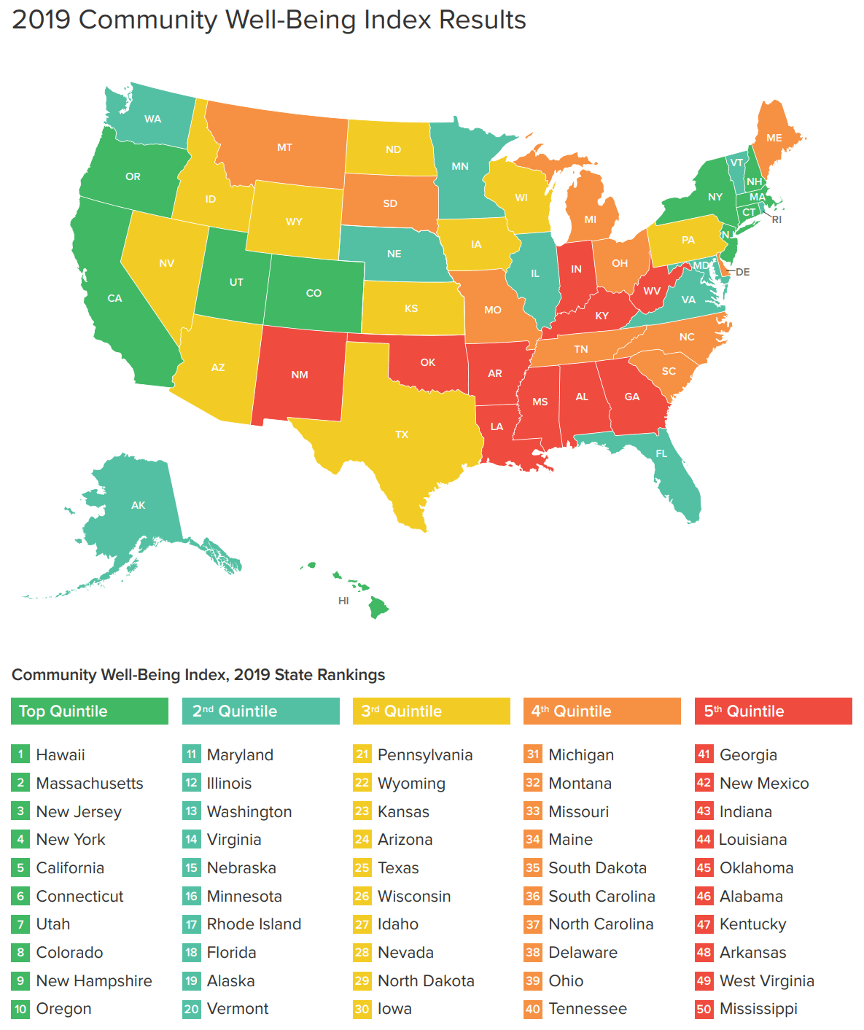Boston University School of Public Health (BUSPH) and Sharecare released a set of three indices to measure population health by state: the (i) Community Well-Being Index (CWBI), (ii) Social Determinants of Health Index (SDOHi), and Well-Being Index (WBI). The CWBI provides an integrated measure that combines individual risk from the WBI with community risk from the SDOHi. Rankings varied within each index. Generally, the states in the top quintile were distributed across the country, from New Hampshire to Hawaii, while the lowest quintile states were concentrated in the Southeastern United States.

Methodology
Although Sharecare has been measuring well-being for the past 10 years, it decided to partner with BUSPH this year to publish the indices. The partnership advanced the collection and analysis of data as well as incorporated community-level social determinants of health (SDOH) measures to form new indices for contextualizing population health.
For the 2019 rankings, Sharecare and BUSPH collected over 360,000 surveys from 99.9% of US counties and all 383 metropolitan statistical areas (MSAs). The data collection efforts sought to capture census-based representation while increasing the number of surveys collected from the prior year, and for the first time, it included increased coverage in rural and underserved areas.
Considerations For Employers
The data in the WBI and SDOHi provide valuable information on individual and community well-being, respectively, and should be reviewed by wellness professionals as they consider the challenges they must face when seeking to improve health. The CWBI offers a combined snapshot that simplifies the current state of individual and community health in areas across the country. Employers can interpret the results in many ways but must also take them with a grain of salt due to changes in the current health environment.
Community Health Impacts Applicant Pool – Employee wellness programs are limited in many ways. Although employees spend a great deal of time at work, the community they live in and the health consequences associated with that community have a great impact on their well-being. This is why employers in an area have a vested interest in improving the factors that impact community health, such as access to food and quality healthcare, because these factors will greatly impact current and future employees and an employee wellness program alone cannot deliver the health outcomes companies desire. For example, imagine an employer in Mississippi trying to create a thriving workforce; it will be much more difficult, in a state ranked last in the CWBI, than in Hawaii, a state ranked first.
COVID-19 Ramifications – As discussed in earlier posts, the likelihood of contracting COVID-19 and experiencing symptoms from the illness are not equal across populations. Specifically, individuals with chronic conditions are more likely to display symptoms from COVID-19. This group also has higher mortality rates. Since community and individual health changes the level of risk for a population, employers from less well regions should take this into consideration when thinking return to work strategies. Also, changes to the retail and healthcare environment that have occurred due to COVID-19 have exacerbated access food and healthcare services. Employers should also be taking these into consideration.
Remote Work – SDOH have always been incredibly important when evaluating the health of a population. Historically, most employers have not given this topic much attention, but in recent years, community health has become a common consideration when thinking about where employers want to open offices and how they can improve the communities they are currently in. Like many things, COVID-19 has changed how important this may be. For employers that expect to move a significant portion of their population to remote work, the impact of SDOH may be less significant, as they can recruit from all areas and are not limited to a specific geography.












